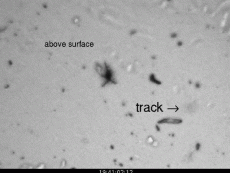Stardust@home
|
Stardust@home | |
|---|---|
 Stardust@home logo | |
 虚拟显微镜的动态对焦效果 | |
| 开发者 | NASA / 加利福尼亚大学伯克利分校 |
| 版本历史 | 2006年8月1日启动 |
| 运算平台 | 支持图像显示的浏览器 / 显示分辨率至少为 800x600 |
| 项目平台 | 独立 |
| 程序情况 | N/A |
| 任务情况 | N/A |
| 项目状态 | 运行中 |
| 项目类别 | 天文学/人工协作类项目 |
| 优化程序 | 无 |
| 计算特点 | CPU密集: |
| 官方网址 | Stardust@home |
| [{{{rss}}} 通过 RSS 获取项目新闻] | |
Stardust@home is a citizen science project that encourages volunteers to search images for tiny interstellar dust impacts. The project began providing data for analysis on August 1, 2006.
From February to May 2000 and from August to December 2002, the Stardust spacecraft exposed its "Stardust Interstellar Dust Collector" (SIDC), a set of aerogel blocks about 0.1 m² (1 ft²) in total size, to interstellar dust. The collector media consist of 130 blocks of 1 and 3 cm thick silica-based aerogel mounted in aluminum cells.
In order to spot impacts of interstellar dust, just over 700,000 individual fields of the aerogel will have to be visually inspected using large magnification. Each field, which is composed of 40 images, will thus be termed a "focus movie." Stardust@home will try to achieve this by distributing the work among volunteers. Unlike distributed computing projects, it does not try to harness the processing power of many computers. It uses them only to distribute and present the tasks to humans. This approach is similar to the earlier Clickworkers project to find Martian craters.
Participants must pass a test to qualify to register to participate. After registering and passing the test, participants have access to the web-based "virtual microscope" which allows them to search each field for interstellar dust impacts by focusing up and down with a focus control.
As an incentive for volunteers, Stardust@home will allow the first individual to discover a particular interstellar dust particle to name it. Also, the discoverer will appear as a co-author on any scientific paper announcing the discovery of the particle.
延伸阅读